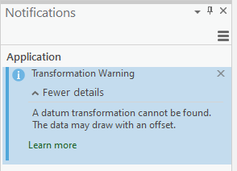- Home
- :
- All Communities
- :
- Products
- :
- ArcGIS Pro
- :
- ArcGIS Pro Ideas
- :
- Enhance the datum transformation warning
- Subscribe to RSS Feed
- Mark as New
- Mark as Read
- Bookmark
- Follow this Idea
- Printer Friendly Page
- Mark as New
- Bookmark
- Subscribe
- Mute
- Subscribe to RSS Feed
- Permalink
The datum transformation warning is singularly unenlightening it it's lack of information and can benefit from some tweaking. The base massage of:
Should be extended include the feature that generated the error. Sorry, my graphic arts skills are not that good so I can't mark up an exhibit. Between the Transformation Warning header and the details I would like to see something like:
Transformation Warning
Feature: {featurename}
Details expansion1
{featurname} is using:
{featureprojection} with
{featuredatumtransformation}
{map} is using:
{mapprojection}
Details expansion2
The esri help text
Respectfully,
Tom
The Transformation Warning only occurs the first time you load a map in a session. If you load a map once then close it then load it again (by clicking on the map in "Maps") it won't issue the warning again. This makes it harder to troubleshoot, because you can't remove a layer and refresh or remove a layer and close and reopen the map.
I wish I could give this idea more than one "kudo".
i totally agree.
i see this warning, can tell that performance is being degraded by slow redraw due to transformations.... BUT... cannot find out easliy which layer is the culprit!
in a typical project i may have 20+ layers. to go through them all to find the error seems so unneccessary.
the software knows that there is a mis-match, as it has just told me but why cant it tell me the specifics. surely this is a tiny bit of additional code to return the layer and its projection in the warning?
perhaps a tab in 'contents' that shows this?
i would also give this loads of kudos but unfortunately can only give one!
I just found my way back to this idea. I see that I already kudoed this a long time back. It's almost three years after the original idea ESRI still hasn't done anything about it. The offending layer has to be known by the system on its way to displaying the warning. The idea is the best solution, but even just including the problem layer name in the message would be a great leap forward.
2025-05-23: Another year has gone by and the problem persists. I am updating this comment to try to bump the idea back onto the ESRI radar screen.
You must be a registered user to add a comment. If you've already registered, sign in. Otherwise, register and sign in.
